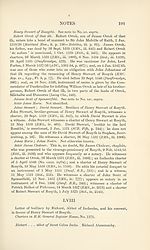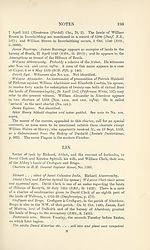Series 3 > Charters of the Abbey of Inchcolm
(245) Page 192
Download files
Complete book:
Individual page:
Thumbnail gallery: Grid view | List view

192 CHARTERS OF THE ABBEY OF INCHCOLM
Henry Stewart of Bossytht. See note to No. lv. supra.
Our verray lauchfull and undoutit bal^eis. In the fifteenth and sixteenth
centuries there are many instances of monasteries appointing as bailies
the lairds of lands adjoining theirs. Thus, in 1414, the office of principal
bailie of Coldingham is conferred on the Earl of Douglas {Priory of
Coldingham, p. 86) and a pension of 10/. is conceded to Alexander Home,
as sub-bailie {ibid., p. 87). In 1441, Sir David Home was made bailie
for a period of forty years {ibid., p. 120). On 14 May 1506, Sir Thomas
Maule of Panmure was made bailie of the barony of Barry by the Abbey
of Balmerino (Campbell, Balmerino, p. 222). In 1551, the nuns of Cold¬
stream appointed Alexander Hume their bailie {RMS., iv. 1709) ; and,
in 1552, Hugh, Earl of Eglinton, was made bailie of the lands of Kilwinning
{ibid., iv. 724). From the monastery’s point of view, it was a method of
conciliating and enlisting the aid of men who, in the period when the
decay of the monasteries was setting in, might have proved troublesome
neighbours. From the layman’s point of view, it was a source of emolu¬
ment and influence. But the office tended to perpetuate itself. The
obtaining of the bailliary over monastic lands not infrequently proved
itself the first step towards obtaining them as a temporal lordship on the
suppression of the monasteries. Thus, the appointment of Hugh Campbell
of Loudoun as bailie of Melrose in that abbey’s lands of Kylesmuir, in
1521, led directly to the erection of the lordship of Kylesmuir, in favour
of Lord Loudoun, in 1606 {Metros, ii. 598; APS., iv. pp. 323-4). The
course of events, however, was somewhat different in the case of Inchcolm.
See Introduction, p. xxx.
Robert Orok of that Ilk. See note to previous chapter.
Johne Orok; David Orok his bredergermane. John Orok was occupier
of the lands of Cragbaith, in 1543, according to a charter of 27 April
of that year {RMS., iii. 2915). As John Orok of that ilk he is mentioned
as household man to the Queen, 6 June 1546 {RSS., iii. 1702), and witnesses
a charter, 14 March 1547 {Laing Chs., 528). Three men of this name
figure in Dunf. B.R.: (1) John Orok, whose wife, Jonet Kynlocht,
appears, 1 June 1489 {op. cit., 13). (2) John Orok, husband of Jonet
Smyth, appears, 1 Jan. 1507 {ibid., 355). It is one or other of these who
appears frequently as a bailie of the burgh {e.g. ibid., 62 (22 Oct. 1495) ;
63 (12 Jan. 1496)) ; and a John Orok is made a burgess, 14 Oct. 1511
{ibid., 181). (3) Sir John Orok, chaplain, mentioned, 1 June 1489 and
23 Nov. 1490, as having the service of Our Lady aisle {ibid., 13, 23).
It may be a fourth John Orok who is designated ‘ smith,’ 17 Jan. 1502
{ibid., 127). All of these are probably distinct from the present John
Orok. His brother David is not mentioned elsewhere. (There is an
earlier David Orok of that ilk mentioned, 10 Oct. 1488 and 31 Oct. 1490
{Dunf. B.R., 10, 310)).
Wil^arne Broune. This is probably William Broun of Coustoun, witness
to an instrument of 8 May 1504 {Wemyss, ii. p. 122) and to an obligation
by Sir William Scott of Balwearie, 6 Feb. 1509/10 {Melvilles, iii. p. 57=
Maitland Misc., ii. p. 130). He is bailie of James Livingstone of Manerston,
Henry Stewart of Bossytht. See note to No. lv. supra.
Our verray lauchfull and undoutit bal^eis. In the fifteenth and sixteenth
centuries there are many instances of monasteries appointing as bailies
the lairds of lands adjoining theirs. Thus, in 1414, the office of principal
bailie of Coldingham is conferred on the Earl of Douglas {Priory of
Coldingham, p. 86) and a pension of 10/. is conceded to Alexander Home,
as sub-bailie {ibid., p. 87). In 1441, Sir David Home was made bailie
for a period of forty years {ibid., p. 120). On 14 May 1506, Sir Thomas
Maule of Panmure was made bailie of the barony of Barry by the Abbey
of Balmerino (Campbell, Balmerino, p. 222). In 1551, the nuns of Cold¬
stream appointed Alexander Hume their bailie {RMS., iv. 1709) ; and,
in 1552, Hugh, Earl of Eglinton, was made bailie of the lands of Kilwinning
{ibid., iv. 724). From the monastery’s point of view, it was a method of
conciliating and enlisting the aid of men who, in the period when the
decay of the monasteries was setting in, might have proved troublesome
neighbours. From the layman’s point of view, it was a source of emolu¬
ment and influence. But the office tended to perpetuate itself. The
obtaining of the bailliary over monastic lands not infrequently proved
itself the first step towards obtaining them as a temporal lordship on the
suppression of the monasteries. Thus, the appointment of Hugh Campbell
of Loudoun as bailie of Melrose in that abbey’s lands of Kylesmuir, in
1521, led directly to the erection of the lordship of Kylesmuir, in favour
of Lord Loudoun, in 1606 {Metros, ii. 598; APS., iv. pp. 323-4). The
course of events, however, was somewhat different in the case of Inchcolm.
See Introduction, p. xxx.
Robert Orok of that Ilk. See note to previous chapter.
Johne Orok; David Orok his bredergermane. John Orok was occupier
of the lands of Cragbaith, in 1543, according to a charter of 27 April
of that year {RMS., iii. 2915). As John Orok of that ilk he is mentioned
as household man to the Queen, 6 June 1546 {RSS., iii. 1702), and witnesses
a charter, 14 March 1547 {Laing Chs., 528). Three men of this name
figure in Dunf. B.R.: (1) John Orok, whose wife, Jonet Kynlocht,
appears, 1 June 1489 {op. cit., 13). (2) John Orok, husband of Jonet
Smyth, appears, 1 Jan. 1507 {ibid., 355). It is one or other of these who
appears frequently as a bailie of the burgh {e.g. ibid., 62 (22 Oct. 1495) ;
63 (12 Jan. 1496)) ; and a John Orok is made a burgess, 14 Oct. 1511
{ibid., 181). (3) Sir John Orok, chaplain, mentioned, 1 June 1489 and
23 Nov. 1490, as having the service of Our Lady aisle {ibid., 13, 23).
It may be a fourth John Orok who is designated ‘ smith,’ 17 Jan. 1502
{ibid., 127). All of these are probably distinct from the present John
Orok. His brother David is not mentioned elsewhere. (There is an
earlier David Orok of that ilk mentioned, 10 Oct. 1488 and 31 Oct. 1490
{Dunf. B.R., 10, 310)).
Wil^arne Broune. This is probably William Broun of Coustoun, witness
to an instrument of 8 May 1504 {Wemyss, ii. p. 122) and to an obligation
by Sir William Scott of Balwearie, 6 Feb. 1509/10 {Melvilles, iii. p. 57=
Maitland Misc., ii. p. 130). He is bailie of James Livingstone of Manerston,
Set display mode to:
![]() Universal Viewer |
Universal Viewer | ![]() Mirador |
Large image | Transcription
Mirador |
Large image | Transcription
Images and transcriptions on this page, including medium image downloads, may be used under the Creative Commons Attribution 4.0 International Licence unless otherwise stated. ![]()
| Scottish History Society volumes > Series 3 > Charters of the Abbey of Inchcolm > (245) Page 192 |
|---|
| Permanent URL | https://digital.nls.uk/128323715 |
|---|
| Attribution and copyright: |
|
|---|
| Description | Over 180 volumes, published by the Scottish History Society, containing original sources on Scotland's history and people. With a wide range of subjects, the books collectively cover all periods from the 12th to 20th centuries, and reflect changing trends in Scottish history. Sources are accompanied by scholarly interpretation, references and bibliographies. Volumes are usually published annually, and more digitised volumes will be added as they become available. |
|---|


